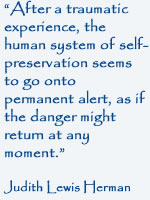If you have experienced trauma, your symptoms, behaviours, and even your beliefs and thoughts, reflect how you tried to adapt to circumstances beyond your control, and how you survived those events. These symptoms can, however, have a very disruptive effect on your current, daily life.
Symptoms and behaviours might include: self-blame to give you an illusion of control in a situation where you had none; anxiety to avoid the slightest possibility of danger ever again; depression to protect against feeling the overwhelming pain that you fear you can’t survive; hypervigilance to keep yourself safe; anger to push others away before they can hurt you; shame to increase your compliance and dull your anger.
In therapy these protective strategies must be respected and understood: they enabled you to survive. It is only through really understanding how they have been protecting you that it becomes possible to transform them.
Your adaptations in response to trauma are your own, there for good reason. While the focus of therapy is in helping you replace those adapations that no longer serve you, this is not done by trying to stop them, but rather by working with your existing strengths, and by developing constructive new ways to build safety and to thrive, so the old adaptations will no longer be needed.
1.Be kind to yourself.
Remind yourself that you are here right now because you have survived. Whatever your survival mechanisms are, and whether they are working for you today or not, they were intended to keep you safe from whatever caused you harm. Be kind to yourself about your anxiety, your depression, or whatever other symptoms you have developed to take care of yourself. Understand that they serve a purpose, and that you have done the best you can with whatever resources were available to you at the time.
2. Do something small and simple that feels good.
Using one of your five senses, start with something very small, the taste of a fresh strawberry, the smell of mown grass, the feel of the sun on your face, and whatever sounds you find soothing. Remind yourself that your body belongs to you, and this pleasure is what it’s capable of feeling, this is something you can build on. There are other ways you can learn to take care of yourself than the ones you know. If this feels really difficult, you might try it for a very short time, even just 15 seconds to start with.
3. Start noticing the things that make you feel better or worse.
Start keeping a record of when you feel bad and when you good or feel less bad, and what might have triggered it. When you first start doing this it may seem like an unsolvable puzzle. But your feelings and responses are not random, and you can start learning about yourself and your reactions. This can begin to give you a sense of control: if certain things cause certain reactions, then maybe there is something you can do about how you are feeling.
Healing Trauma. By Dr. Peter Levine. Physician and trauma expert explains how trauma lives on in the body and some ways of understanding this with many straightforward exercises to aid recovery. Any of Peter Levine's books on trauma recovery are useful.
Transforming the Living Legacy of Trauma. A Workbook for Survivors and Therapists. By Dr Janina Fisher. Written for clients this offers simple explanations to make sense of confusing feelings and physical reactions, the impact on the body of trauma and the constant reaction of the body to triggers. It also offers step-by-step strategies that can be used on your own or with a therapist for recovery.
The Body Keeps the Score. By Bessel van der Kolk. The second half of the book is an easier read and takes a practical look at a rounded recovery that includes but is not limited to therapy. The first half of the book looks at the physiological impact of trauma: what happens in a person's body when they are traumatised and how many of the physical reactions and symptoms they experience are disconnected memories - not forgotten, but disconnected.
Sensorimotor Psychotherapy. By Pat Ogden and Dr Janina Fisher. A book written for clients and their therapists. The impact of trauma lives on in the responses of the body, and this type of very effective therapy, deals with the ongoing impact of trauma in daily felt experience and how to work towards recovery and relief.
Trauma and Recovery. By Judith Herman. A classic and essential book that looks at the roots of Post Traumatic Stress Disorder and the Stages of Recovery. Written more for therapists, and quite a solid read, however survivors may also find it useful.



